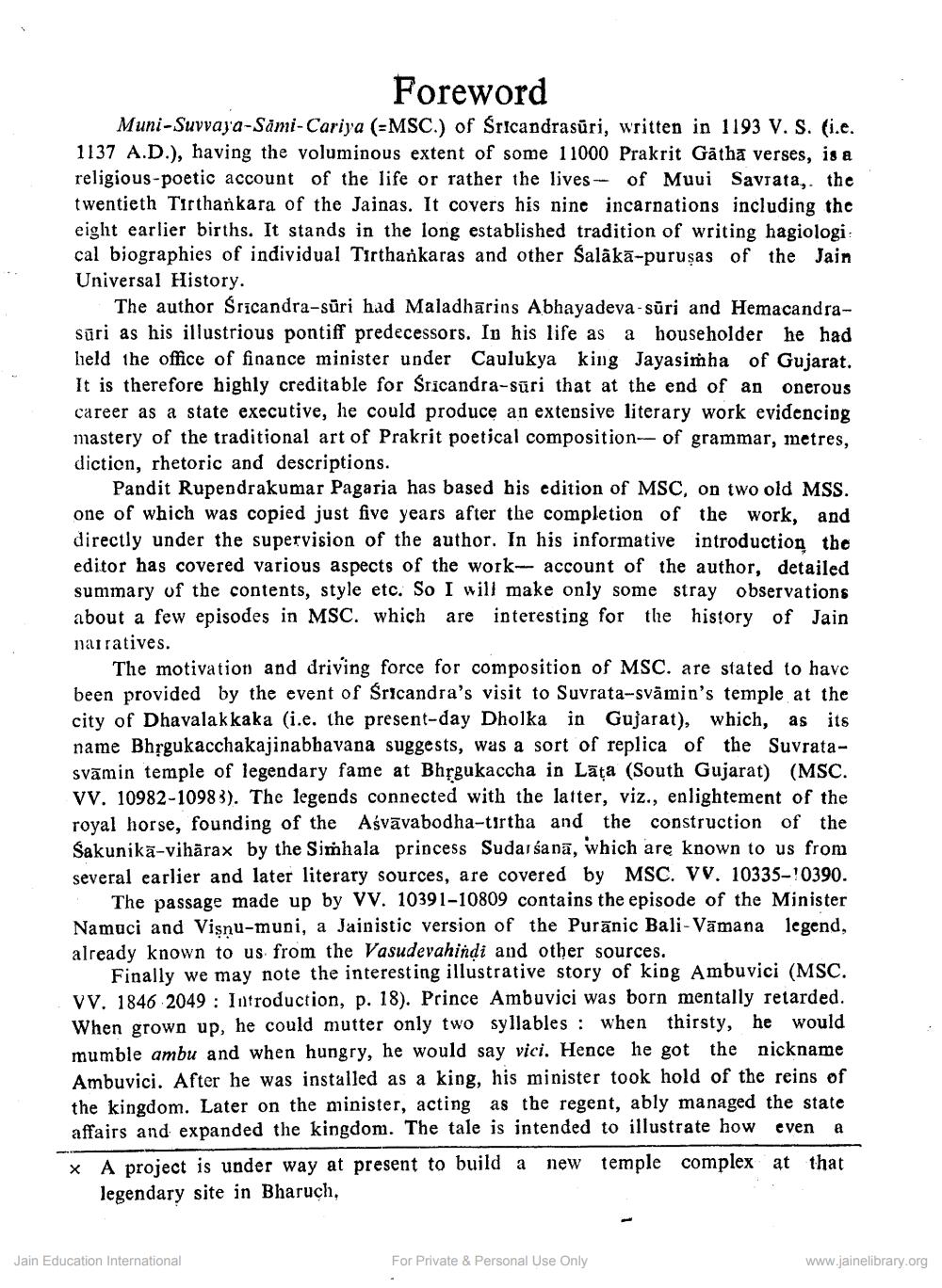Book Title: Munisuvratasvamicarita Author(s): Chandrasuri, Rupendrakumar Pagariya, Yajneshwar S Shastri, R S Betai Publisher: L D Indology Ahmedabad View full book textPage 8
________________ Foreword Muni-Suvvaya-Sami-Cariya (=MSC.) of Sricandrasūri, written in 1193 V. S. (i.e. 1137 A.D.), having the voluminous extent of some 11000 Prakrit Gâtha verses, is a religious-poetic account of the life or rather the lives - of Muui Savrata, the twentieth Tirthankara of the Jainas. It covers his nine incarnations including the eight earlier births. It stands in the long established tradition of writing hagiologi cal biographies of individual Tirtharkaras and other Salākā-puruşas of the Jain Universal History. The author Sricandra-süri had Maladhārins Abhayadeva-sūri and Hemacandrasūri as his illustrious pontiff predecessors. In his life as a householder he had held the office of finance minister under Caulukya king Jayasimha of Gujarat. It is therefore highly creditable for Sricandra-sūri that at the end of an onerous career as a state executive, he could produce an extensive literary work evidencing mastery of the traditional art of Prakrit poetical composition-- of grammar, metres, diction, rhetoric and descriptions. Pandit Rupendrakumar Pagaria has based his edition of MSC, on two old MSS. one of which was copied just five years after the completion of the work, and directly under the supervision of the author. In his informative introduction the editor has covered various aspects of the work- account of the author, detailed summary of the contents, style etc. So I will make only some stray observations about a few episodes in MSC. which are interesting for the history of Jain narratives. The motivation and driving force for composition of MSC. are stated to have been provided by the event of Sricandra's visit to Suvrata-svämin's temple at the city of Dhavalakkaka (i.e. the present-day Dholka in Gujarat), which, as its name Bhrgukacchakajinabbavana suggests, was a sort of replica of the Suvratasvāmin temple of legendary fame at Bhțgukaccha in Lāța (South Gujarat) (MSC. VV. 10982-10983). The legends connected with the latter, viz., enlightement of the royal horse, founding of the Aśvāvabodha-tirtha and the construction of the Sakunikā-vihārax by the Simhala princess Sudarśana, which are known to us from several earlier and later literary sources, are covered by MSC. VV. 10335-!0390. The passage made up by VV. 10391-10809 contains the episode of the Minister Namuci and Vişnu-muni, a Jainistic version of the Purānic Bali-Vāmana legend, already known to us from the Vasudevahindi and other sources. Finally we may note the interesting illustrative story of king Ambuvici (MSC. VV. 1846 2049 : Introduction, p. 18). Prince Ambuvici was born mentally retarded. When grown up, he could mutter only two syllables : when thirsty, he would mumble ambu and when hungry, he would say vici. Hence he got the nickname Ambuvici. After he was installed as a king, his minister took hold of the reins of the kingdom. Later on the minister, acting as the regent, ably managed the state affairs and expanded the kingdom. The tale is intended to illustrate how even a * A project is under way at present to build a new temple complex at that legendary site in Bharuch, Jain Education International For Private & Personal Use Only www.jainelibrary.orgPage Navigation
1 ... 6 7 8 9 10 11 12 13 14 15 16 17 18 19 20 21 22 23 24 25 26 27 28 29 30 31 32 33 34 35 36 37 38 39 40 41 42 43 44 45 46 47 48 49 50 51 52 53 54 55 56 57 58 59 60 61 62 63 64 65 66 67 68 69 70 71 72 73 74 75 76 77 78 79 80 81 82 ... 376
